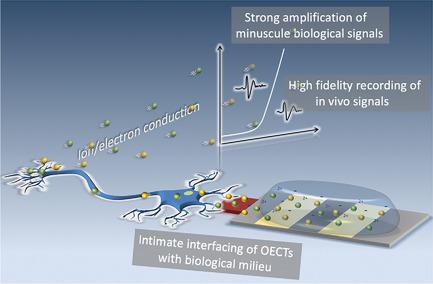当前位置:
X-MOL 学术
›
Adv. Mater.
›
论文详情
Our official English website, www.x-mol.net, welcomes your
feedback! (Note: you will need to create a separate account there.)
Organic Electrochemical Transistors for In Vivo Bioelectronics
Advanced Materials ( IF 27.4 ) Pub Date : 2021-10-04 , DOI: 10.1002/adma.202101874
Ali Nawaz 1, 2 , Qian Liu 3 , Wei Lin Leong 4 , Kathryn E Fairfull-Smith 3, 5 , Prashant Sonar 3, 5, 6
Advanced Materials ( IF 27.4 ) Pub Date : 2021-10-04 , DOI: 10.1002/adma.202101874
Ali Nawaz 1, 2 , Qian Liu 3 , Wei Lin Leong 4 , Kathryn E Fairfull-Smith 3, 5 , Prashant Sonar 3, 5, 6
Affiliation

|
Organic electrochemical transistors (OECTs) are presently a focus of intense research and hold great potential in expanding the horizons of the bioelectronics industry. The notable characteristics of OECTs, including their electrolyte-gating, which offers intimate interfacing with biological environments, and aqueous stability, make them particularly suitable to be operated within a living organism (in vivo). Unlike the existing in vivo bioelectronic devices, mostly based on rigid metal electrodes, OECTs form a soft mechanical contact with the biological milieu and ensure a high signal-to-noise ratio because of their powerful amplification capability. Such features make OECTs particularly desirable for a wide range of in vivo applications, including electrophysiological recordings, neuron stimulation, and neurotransmitter detection, and regulation of plant processes in vivo. In this review, a systematic compilation of the in vivo applications is presented that are addressed by the OECT technology. First, the operating mechanisms, and the device design and materials design principles of OECTs are examined, and then multiple examples are provided from the literature while identifying the unique device properties that enable the application progress. Finally, one critically looks at the future of the OECT technology for in vivo bioelectronic applications.
中文翻译:

用于体内生物电子学的有机电化学晶体管
有机电化学晶体管 (OECT) 目前是深入研究的焦点,在扩展生物电子行业的视野方面具有巨大潜力。OECT 的显着特征,包括它们的电解质门控,提供与生物环境的密切接触,以及水稳定性,使它们特别适合在活的有机体(体内)中操作。与现有的体内生物电子器件主要基于刚性金属电极不同,OECTs 与生物环境形成柔软的机械接触,并由于其强大的放大能力确保了高信噪比。这些特性使得 OECTs 特别适合广泛的体内应用,包括电生理记录、神经元刺激和神经递质检测,和体内植物过程的调节。在这篇综述中,系统地汇编了 OECT 技术解决的体内应用程序。首先,研究了 OECT 的运行机制、器件设计和材料设计原理,然后从文献中提供了多个示例,同时确定了能够促进应用进展的独特器件特性。最后,批判性地审视了 OECT 技术在体内生物电子应用中的未来。然后从文献中提供了多个示例,同时确定了支持应用程序进展的独特设备属性。最后,批判性地审视了 OECT 技术在体内生物电子应用中的未来。然后从文献中提供了多个示例,同时确定了支持应用程序进展的独特设备属性。最后,批判性地审视了 OECT 技术在体内生物电子应用中的未来。
更新日期:2021-12-07
中文翻译:

用于体内生物电子学的有机电化学晶体管
有机电化学晶体管 (OECT) 目前是深入研究的焦点,在扩展生物电子行业的视野方面具有巨大潜力。OECT 的显着特征,包括它们的电解质门控,提供与生物环境的密切接触,以及水稳定性,使它们特别适合在活的有机体(体内)中操作。与现有的体内生物电子器件主要基于刚性金属电极不同,OECTs 与生物环境形成柔软的机械接触,并由于其强大的放大能力确保了高信噪比。这些特性使得 OECTs 特别适合广泛的体内应用,包括电生理记录、神经元刺激和神经递质检测,和体内植物过程的调节。在这篇综述中,系统地汇编了 OECT 技术解决的体内应用程序。首先,研究了 OECT 的运行机制、器件设计和材料设计原理,然后从文献中提供了多个示例,同时确定了能够促进应用进展的独特器件特性。最后,批判性地审视了 OECT 技术在体内生物电子应用中的未来。然后从文献中提供了多个示例,同时确定了支持应用程序进展的独特设备属性。最后,批判性地审视了 OECT 技术在体内生物电子应用中的未来。然后从文献中提供了多个示例,同时确定了支持应用程序进展的独特设备属性。最后,批判性地审视了 OECT 技术在体内生物电子应用中的未来。

































 京公网安备 11010802027423号
京公网安备 11010802027423号